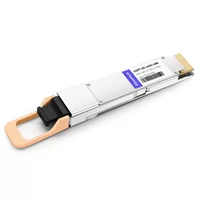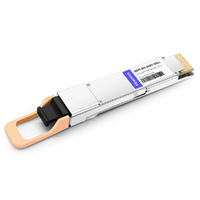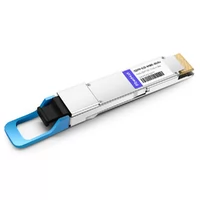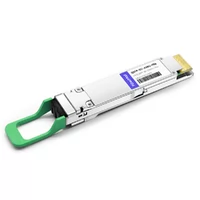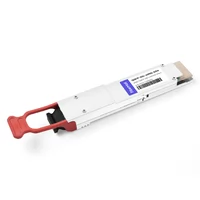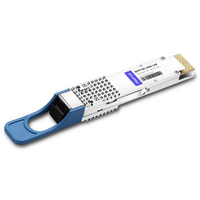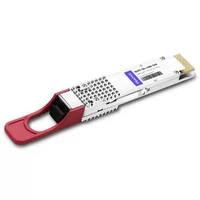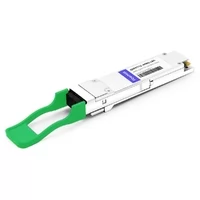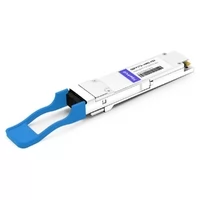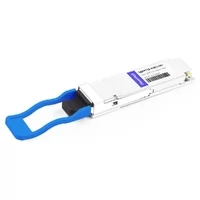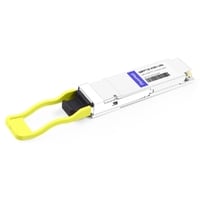Anyone familiar with optical transceivers knows that the size of an optical transceiver is determined by the form factor. Common SFP, SFP+, XFP, QSFP+, QSFP28, etc. are stipulated by various multi-source agreement (MSA)organizations. Next, let’s talk about the optical transceiver MSA multi-source agreement.
Table of Contents
ToggleThe Origin and Introduction of the MSA Standard
As the world’s largest professional technical organization, IEEE (Institute of Electrical and Electronics Engineers) has established standards for optical transceivers, but the types of optical module interfaces from different manufacturers are diverse. In order to solve the problem of insufficient interoperability, multiple manufacturers jointly established an organization to standardize the interface types, installation, and functions of optical modules, and MSA came into being to supplement the IEEE standards.
The MSA is commonly referred as the SFP Transceiver MSA, also known as the SFP-MSA agreement.
-1024x402.png)
MSA (Multi-source Agreement)
MSA was submitted to SFF and named INF-8074i.SFF extended the SFP-MSA agreement and the extended agreement was SFF-8472.SFF refers to the Small Form Factor Committee. It is a research committee that seeks for solutions and develops corresponding standards for problems that the industry does not have standards but urgently need to be solved.
The INF-8074i agreement standardizes the definition of mechanical structure, electrical interface and software interface. SFF-8472 standardizes module identification, manufacturer information, and digital diagnostic monitoring (DDM) functions of optical transceivers. MSA-compliant products include optical transceivers, fiber optic patch cords and other network equipment.
MSA Standard and Optical Transceiver
For optical transceivers, the MSA standard not only defines the overall dimensions, but also defines its electrical and optical interface. Therefore, optical transceiver suppliers must strictly abide by the MSA standard when designing systems to ensure operability and interchangeability between optical transceivers.
At the same time, MSA provides end users with a variety of choices. Since optical transceiver that comply with MSA standards have the same shape and size, third-party optical transceiver suppliers can also compete with mainstream brand manufacturers, win optical transceiver market share, and provide what users need. They reduce network construction costs for end users and prevent optical transceiver market from being monopolized.
Tracing the development of the MSA organization from the earliest defined GBIC MSA specification, MSA has accelerated the acceptance process of SFP+, CFP, QSFP-DD and other optical transceivers, thereby promoting optical transceivers to support higher-speed 400G bandwidth.
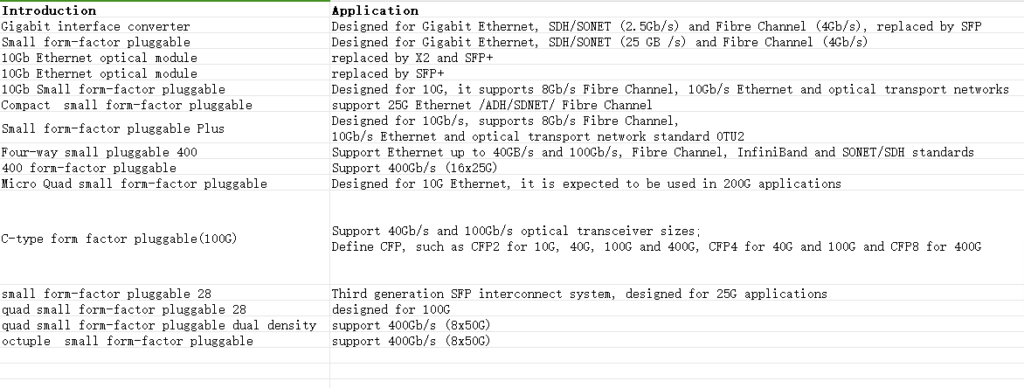
Approved optical transceiver MSA
With the development of technology, the size of optical transceivers will become smaller and smaller, and the data capacity transmitted per unit time will also become larger and larger. This also means that new MSAs will continue to appear in the future.
Related Products:
-
 QSFP-DD-400G-SR8 400G QSFP-DD SR8 PAM4 850nm 100m MTP/MPO OM3 FEC Optical Transceiver Module
$149.00
QSFP-DD-400G-SR8 400G QSFP-DD SR8 PAM4 850nm 100m MTP/MPO OM3 FEC Optical Transceiver Module
$149.00
-
 QSFP-DD-400G-DR4 400G QSFP-DD DR4 PAM4 1310nm 500m MTP/MPO SMF FEC Optical Transceiver Module
$400.00
QSFP-DD-400G-DR4 400G QSFP-DD DR4 PAM4 1310nm 500m MTP/MPO SMF FEC Optical Transceiver Module
$400.00
-
 QSFP-DD-400G-SR4.2 400Gb/s QSFP-DD SR4 BiDi PAM4 850nm/910nm 100m/150m OM4/OM5 MMF MPO-12 FEC Optical Transceiver Module
$900.00
QSFP-DD-400G-SR4.2 400Gb/s QSFP-DD SR4 BiDi PAM4 850nm/910nm 100m/150m OM4/OM5 MMF MPO-12 FEC Optical Transceiver Module
$900.00
-
 QSFP-DD-400G-XDR4 400G QSFP-DD XDR4 PAM4 1310nm 2km MTP/MPO-12 SMF FEC Optical Transceiver Module
$580.00
QSFP-DD-400G-XDR4 400G QSFP-DD XDR4 PAM4 1310nm 2km MTP/MPO-12 SMF FEC Optical Transceiver Module
$580.00
-
 QSFP-DD-400G-FR4 400G QSFP-DD FR4 PAM4 CWDM4 2km LC SMF FEC Optical Transceiver Module
$500.00
QSFP-DD-400G-FR4 400G QSFP-DD FR4 PAM4 CWDM4 2km LC SMF FEC Optical Transceiver Module
$500.00
-
 QSFP-DD-400G-LR4 400G QSFP-DD LR4 PAM4 CWDM4 10km LC SMF FEC Optical Transceiver Module
$600.00
QSFP-DD-400G-LR4 400G QSFP-DD LR4 PAM4 CWDM4 10km LC SMF FEC Optical Transceiver Module
$600.00
-
 QSFP-DD-400G-ER4 400G QSFP-DD ER4 PAM4 LWDM4 40km LC SMF without FEC Optical Transceiver Module
$3500.00
QSFP-DD-400G-ER4 400G QSFP-DD ER4 PAM4 LWDM4 40km LC SMF without FEC Optical Transceiver Module
$3500.00
-
 QSFP-DD-400G-LR8 400G QSFP-DD LR8 PAM4 LWDM8 10km LC SMF FEC Optical Transceiver Module
$2500.00
QSFP-DD-400G-LR8 400G QSFP-DD LR8 PAM4 LWDM8 10km LC SMF FEC Optical Transceiver Module
$2500.00
-
 QSFP-DD-400G-ER8 400G QSFP-DD ER8 PAM4 LWDM8 40km LC SMF FEC Optical Transceiver Module
$3800.00
QSFP-DD-400G-ER8 400G QSFP-DD ER8 PAM4 LWDM8 40km LC SMF FEC Optical Transceiver Module
$3800.00
-
 QSFP112-400G-LR4 400G QSFP112 LR4 PAM4 CWDM 10km Duplex LC SMF FEC Optical Transceiver Module
$1500.00
QSFP112-400G-LR4 400G QSFP112 LR4 PAM4 CWDM 10km Duplex LC SMF FEC Optical Transceiver Module
$1500.00
-
 QSFP112-400G-FR4 400G QSFP112 FR4 PAM4 CWDM 2km Duplex LC SMF FEC Optical Transceiver Module
$750.00
QSFP112-400G-FR4 400G QSFP112 FR4 PAM4 CWDM 2km Duplex LC SMF FEC Optical Transceiver Module
$750.00
-
 QSFP112-400G-FR1 4x100G QSFP112 FR1 PAM4 1310nm 2km MTP/MPO-12 SMF FEC Optical Transceiver Module
$1200.00
QSFP112-400G-FR1 4x100G QSFP112 FR1 PAM4 1310nm 2km MTP/MPO-12 SMF FEC Optical Transceiver Module
$1200.00
-
 QSFP112-400G-DR4 400G QSFP112 DR4 PAM4 1310nm 500m MTP/MPO-12 with KP4 FEC Optical Transceiver Module
$650.00
QSFP112-400G-DR4 400G QSFP112 DR4 PAM4 1310nm 500m MTP/MPO-12 with KP4 FEC Optical Transceiver Module
$650.00
-
 QSFP112-400G-SR4 400G QSFP112 SR4 PAM4 850nm 100m MTP/MPO-12 OM3 FEC Optical Transceiver Module
$450.00
QSFP112-400G-SR4 400G QSFP112 SR4 PAM4 850nm 100m MTP/MPO-12 OM3 FEC Optical Transceiver Module
$450.00

